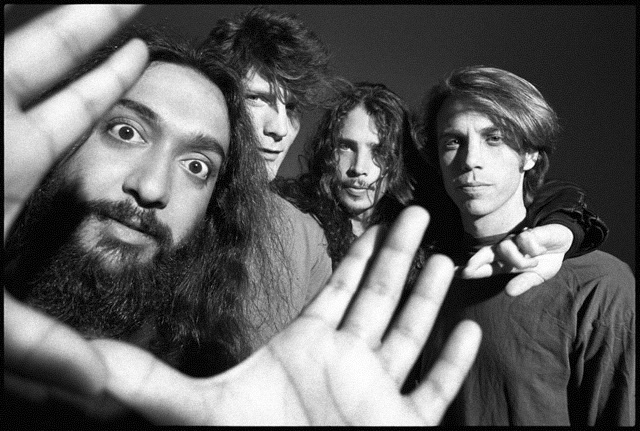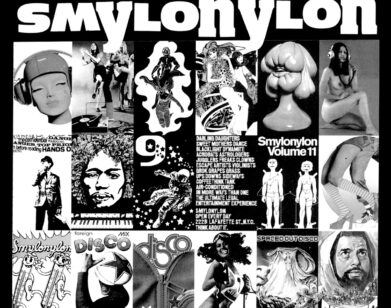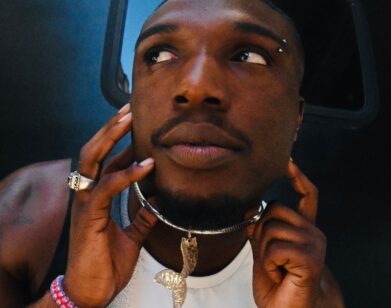The Archivist

Sonic Youth in 1988, courtesy of Michael Lavine; Grunge; Abrams Image; 2009
Thurston Moore broke into the underground rock scene almost thirty years ago with his noisey, distorted, strange, dissonant, and intense rock band Sonic Youth. The sound they created was both incredibly singular-no band could make its guitars squeal quite like theirs-and yet sounded perfectly comfortable among the various scenes and sounds that ebbed through the American underground like glacial flows.
In the process, Moore has evolved into something like punk rock’s chief public archivist. For years, he’s penned the Bull Tongue column for new music with rock historian Byron Coley in Arthur Magazine and has produced and edited numerous books about music subcultures. This fall, Moore has once again teamed up with the art book publisher Abrams Image to produce another book about a punk rock, Grunge.
By no means a definitive history of the era and its music, Grunge is more accurately described as a collection of photographs by the acclaimed New York photographer Michael Lavine, who started chronicling the unique street punk style of Seattle’s Capitol Hill as a fledgling photographer in the mid-1980s. Lavine later developed a relationship with Seattle’s Sub Pop record lable, famous for signing many of the era’s biggest bands including Nirvana, Mudhoney, and Soundgarden, and photographed them in his now-iconic high contrast black and white style.
ALEX SHERMAN: Can you help me out a little bit? I’m having trouble understanding why you felt an urgency to make a book about grunge music.
THURSTON MOORE: It was not supposed to be a book about grunge. The initial idea was to do a book with [photographer] Michael Lavine. He’s someone I’ve always worked with since the 80’s and he has such a history of work when he first started shooting bands like Mudhoney, Nirvana, Buttonhole Surfers, and Pussy Galore. We started looking at this really early work he did as a photography art student at Evergreen College in Olympia, Washington, when he started going to Seattle and shooting all the punks hanging out at Capitol Hill. It was all black and white and evocative and beautiful and it sort of dawned on us that the style of the individuals he was shooting led into how a lot of the so-called grunge bands started looking and dressing and presenting themselves. It’s sort of the most genuine survey of what people know of grunge as a style, but we never thought we would have called the book that. There was a very close relationship between what was going on between these kids on the street and these bands, so we started calling it “The Grunge Book” just as a working title.
SHERMAN: How closely were you working with Michael on editing and sequencing the book?
MOORE: Michael did a mock up of the idea that eventually came into fruition, those early street photographs and then some of photos of bands like Nirvana, et. al. For the cover he had chosen a picture of Kurt Cobain with the word “grunge” stenciled on his forehead. I looked at that and thought it was so audacious.
SHERMAN: Really? Was that something Kurt or Michael did? (PHOTO: SEATTLE, 1983 COURTESY OF MICHAEL LAVINE; GRUNGE; ABRAMS IMAGE; 2009)
MOORE: Michael did that. I just thought about how cool Michael’s cover looked. It embraced that word and put it in a perspective that was actually really sort of true to what it was. I think that’s really what these photographs are about. The last thing we wanted to do was make a history book of grunge. I couldn’t think of anything more boring! And I think it’s misleading for people to see this book called “Grunge.” They’re going to think this is a history of a sub-genre of punk rock. And in one sense it is. But it’s not a detailed timeline history of that movement at all. It’s more of an artist book [about Michael Lavine].
SHERMAN: Where did the term “grunge” come from?
MOORE: That word “grunge” came out of Sub Pop records as a joke to the New York Times to create a terminology of what all these bands at the time were doing. The mass media then ran with it and it became this thing fashion picked up on, particularly through that infamous line of Marc Jacobs, his grunge line. So it became this universal term like, you know, when “punk rock” changed they started calling it “new wave.”
SHERMAN: After reading No Wave, the book you did with Byron Coley [a definitive photographic history of the crude, over-stylized radical fringe of punk that existed New York in the late 1970s], I couldn’t help but expect something more like a definitive history.
MOORE: Well we wanted No Wave to be a definitive history and really create definite parameters -knowing who the individuals were, what the events were, where it came from, and how it ended. And that’s it. We weren’t really interested in everything else that uses No Wave as a reference. We were interested in what was really defined in No Wave and we wanted to make sure that the book defined it as a New York movement of punk rock. As soon as anyone played any semblance of real rock n’ roll, it was over. Grunge is basically a survey of photographs by Michael Lavine that caught the earliest proponents of what grunge would be. But it’s not a timeline.
SHERMAN: To me, though, the book tells a story of innocence lost, especially how it “ends” with Nirvana.(PHOTO: SOUNDGARDEN, 1989 COURTESY OF MICHAEL LAVINE; GRUNGE; ABRAMS IMAGE; 2009)
MOORE: Well, we honestly weren’t trying to find the defining moments of grunge. We were trying to create a kind of revolt. Using that photo of Kurt at the end did make a lot of sense in terms of what that was supposed to reflect. But one of the last photos in the book is one of the earliest photos of Nirvana, with their first drummer Chad [Channing]. The photos of bands at the end isn’t chronological at all. It’s pretty loose. It’s supposed to be this sort of explosion.
SHERMAN What was your intent behind shuffling things around?
MOORE: There was definitely a conscious editorial decision not to have to be chronologically true with the band photos. It was very important to me and Michael that the book flowed with the dynamic of the images. We really worked together on that. But we wanted the photographer to have a lot of say in how the book moved, and a lot of it is Michael Lavine. There was some push and pull with some decisions in what was used and what was not used. But in the end I was just a collaborator.
SHERMAN: Did anyone ask not to be included in the book? I mean, do people continue to be sort of defensive about the word “grunge”?
MOORE: No one asked not to be included. [Laughs.] But I think maybe the Meat Puppets or the Smashing Pumpkins or Pearl Jam or Butthole Surfers or the members of those bands would look at this book and roll their eyes and see this as the last thing they want to be a part of. But when you read it-and there’s not much to read in there-they’ll see the context and whatever kind of intellectual perspective we’ve made up. I showed it to Byron Coley the other day and he just blanched. He said, “This is what this project is called? It became ‘Grunge’? What the fuck are you doing?” Then he started reading it and he got it. I think people are going to roll their eyes and ask, “Why’s he calling it such a corny name?” But it’s a reclamation of sorts. I think the forward begins with the words, “Bad name. Period.” I think it’s kind of funny we’re giving it that title. It’s like making a book called “Art Rock.”
SHERMAN: When I started reading through the book I started jotting down questions I wanted to ask you. Why’d you make this choice? Why’d you make that choice? But at the end of the day I kind of gave up on that. Why split hairs now? Because it’s entertaining? Ultimately, I just wanted to know if you anticipated being put on the defensive about this over a decade later.
MOORE: We almost have to be defensive with a book called Grunge.
SHERMAN: Are you inviting that reaction?
MOORE: Yeah, I guess we’re inviting it. It’s sort of the nature of that name anyway. If the book had existed with just those early street photographs, I think it would be successful as a book called “Grunge.” And we considered doing just a book of those early photographs, exhibiting this sort of style on the streets of Seattle, with the torn jeans and the torn flannel and the hair styles. It was truly this sort of unique underground American thing and we thought about turning it into a book. The whole high fashion concept of grunge, this is the real deal of it right here. But we never really thought about calling it “Grunge.” The fact that we had photographs of bands from that scene, and then bands from other places like Pussy Galore and White Zombie, we wanted to show the connections that existed in the subculture. We all knew who each other were. It was all pre-Internet and the connections were made by traveling and fan zines. There was just no other media that we shared.
SHERMAN: Earlier this week you announced the launch of your new art book imprint, Ecstatic Peace Library. How long has that been in the works?
MOORE: I’ve been doing book editing for a number of years through an editor that I’ve worked with both at Rizzoli and at Abrams named Eva Prinz. First was Mixtape: The Art of Cassette Culture and then a book called Punk House: Interiors in Anarchy. She’s an independent editor right now and we’ve always talked about doing an independent art book imprint where we would work together. She’s kind of established the imprint which will be distributed through D.A.P., Distributed Art Publishers.
SHERMAN: Is it related to your Ecstatic Peace record label?
MOORE: I’ve always used the Ecstatic Peace name for a lot of the production work I do. Ecstatic Peace Library should be distinguished from the record label.
SHERMAN: I saw the roster of projects you have in the works. Will it be mainly Sonic Youth-related books?
MOORE: Not at all. The first book, which is coming out in a couple of weeks, is the work of photographer Justine Kurland, who has a show opening next week [called “This Train Is Bound For Glory” at the Mitchell-Innes and Nash gallery in New York]. The next is the work of Kim Gordon and a number of paintings she’s done. We’re doing a book with Raymond Pettibon and a book of Dave Markey’s work called Party With Me Punker. He documented a lot of the early Southern L.A. hardcore scene centered around SST records and the Minutemen and it’s going to have a lot of really great photos of those bands when they were first starting. We also have a book of photography by James Hamilton, a photographer who worked at the Village Voice and has an amazing archive of work. We have a lot of ideas we’re thinking about doing.
SHERMAN: When did you first get interested in making books?
MOORE: I’ve always done fan-zines and poetry journals but it’s been very subterranean. As far as overground press, this is a big deal for us. I’ve always had bookmaking as an adjunct thing, aside from being in a rock band [laughs]. But I’ve worked with books for as long as I’ve worked with music. I archive post-war poetry and have a huge collection of poetry journals and zines from second and third generation New York School poets.
SHERMAN: Any plans to include media with the books?
MOORE: A lot of these books are going to incorporate recordings on 7″ vinyl. The Dave Markey book will come, I believe, with a 7″ of Mike Watt from the Minutemen doing a recitation of lyrics from back in the early 80s and it’s pretty cool. The Raymond Pettibon project will have a 7″ with it, but what specifically will be determined by how that book transpires.
SHERMAN: Why package a book with vinyl? Why not a CD or an MP3 coupon or something like that?
MOORE: I’m really into new ways of looking at selling recordings-nobody buys records anymore!-and to have them sort of be part of a book experience. You’re going to get two formats that are kind of, for me, completely immortal: the book and the record. I don’t think we’ll have any digital media going on, as I foresee.
SHERMAN: You mean there won’t be an app for that?
MOORE: I’m not against it, but I have absolutely no passion for iPhone apps whatsoever. For reality’s sake, that’s where a lot of revenue is for those things, so maybe they’ll exist for the consumer who likes that kind of convenience. But I’m really into the tactile experience of the record. I don’t like books that have CD’s. I know it’s more convenient for 99 percent of the world, but my ambition is not convenience.
SHERMAN: What’s the Pettibon book going to look like? Is that going to be something like a career retrospective?
MOORE: We’re going to focus on Raymond’s work as a commentary on the early 80’s American hardcore scene-the punk rockers and such. That’s how I first came to Raymond, when he was an artist working within SST Records, his brother Greg Ginn’s record label, Ginn being the mastermind behind Black Flag. A lot of us came to know Raymond through that work before the art world came to him. One of the first people to write about him in an art world context was Kim Gordon, my wife, so it was very exciting to see him become a blue chip artist in the art world through the years. It was almost on par with Nirvana becoming a mainstream success story in the record industry, coming from the underground scene.
SHERMAN: Sounds like we should look forward to picking up the next Sonic Youth album packaged like a book.
MOORE: I’ve always had the notion of the next Sonic Youth record being something that is as much a literary experience as it is an audio experience. Records have always been like that for me anyway. I’ve always been attracted to artists who make music and records that have that kind of aesthetic. From Lou Reed to Patti Smith to Tom Verlaine to Richard Hell, I’ve always been interested in people who do music as literature. Sonic Youth has always been about that for me more or less anyway.
SHERMAN: Are these going to be niche releases? How large of a run will you do with these books?
MOORE: That will be a decision made between my editor and her relationship with D.A.P. I’m leaving it in their hands. I’m pretty much the creative figurehead. [Laughs.] When I make poetry journals, I’ll just make 100 or so just to make sure they sell out.
SHERMAN: Will you still be doing books with Abrams Image?
MOORE: Yes. Byron Coley and I are doing a book with them now on the literary counterculture of the Lower East Side in the 1960s centered around The Fugs and Tuli Kupferberg and such. There are just too many ideas, and I’m trying to parse it in a way that doesn’t become overwhelming.






